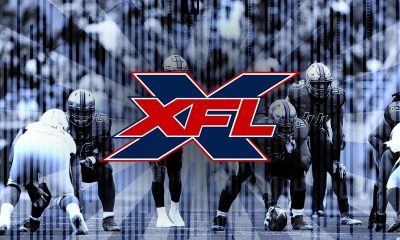STAMFORD, CONN. (Tuesday, January 16, 2001) – Highlighted by the banning of fair catches on punts, the XFL today announced key rules changes for the league’s upcoming season. In addition to eliminating fair catches, the XFL has also modified current punting rules in several other ways to introduce the “most exciting fourth down in football.” Most prominently among these changes is the fact that in the XFL, any punt traveling more than 25 yards will be a live ball recoverable by either team.
“You can sure that no fan will get a drink or go to the bathroom during an XFL punt,” said XFL President Basil V. DeVito, Jr. “When the punter lets fly anything can happen. The strategic possibilities are endless.”
With the banning of the fair catch also comes protection for punt returners in the form of a five-yard protective “halo” by potential tacklers until the punt is caught, and members of the kicking team will not be able to release from the line of scrimmage until the ball is kicked.
Another major XFL rules change involves the point after touchdown, which also has been changed to eliminate what has become football’s most automatic score. In the XFL, there will be no PAT kicks, instead teams will have to run or pass from the two-yard line to score one point. What’s more, since the clock will be running during this play, any fumbled or intercepted attempt can be returned by the defending team for a one point score of its own.
Taking two pages out of the college rules book, the XFL will require that a receiver or defender need only one foot inbounds to make a reception or interception, and that a quarterback is deemed down when his forward progress is halted, thus there is no “in-the-grasp” rule.
Contrary to some reports, XFL quarterbacks will be protected should they slide or otherwise give themselves up and headslaps are illegal.
In the other major rules changes, the XFL will return to the good old days of pass defense as defensive backs will be able to employ the “bump and run” all the way down the field. The league will also utilize a 35-second clock between plays when the clock has been stopped, 25 seconds when there is no stoppage in time.
“We haven’t really invented any totally new plays but have incorporated certain rules from other professional and collegiate leagues, past and present, to create a faster-paced, higher-excitement brand of football,” said XFL Vice President of Football Operations Mike Keller.
In addition to these rules changes, the XFL also announced that no game will end in a tie due to its “can you top this” overtime rule, in which both teams will get the ball at least once. Each team will get four downs to score from the opponent’s 20 yard line. However, if team A scores a touchdown in less that four downs, team B only gets that many downs to respond.
Should neither team score, or should each team score the same amount of points on the same down, the first time around, they’ll do it again until there’s a winner.
“We think we have come up with an innovative, unique and fair way to decide a game which tied after regulation,” said Keller. “We wanted both teams to get the ball at least once in overtime, but if the first team scores a touchdown on the first play, everyone in the building and everyone watching on TV will know that if the second team doesn’t put it in the end zone on the first play, the game is over.”
All of the league’s rules will soon be available when the XFL distributes its first-ever Rules Book prior to the start of the season on February 3. All XFL rules will be posted on the league’s Web site, XFL.com.
HOW DO XFL RULES DIFFER?
The major rule changes adopted include:
· THE MOST EXCITING FOURTH DOWN IN FOOTBALL: No fair catches are permitted, but the returning player is granted a 5-yard protected area or “halo” where a member of the kicking team may not encroach until the ball is touched, and the kicking team may not cross the line of scrimmage until the ball is punted. At the same time, any punt traveling more than 25 yards past the line of scrimmage is a live ball and can be recovered by either team.
· POINT AFTER TOUCHDOWN: There will be no kicking of extra points. Teams will run a play from the two-yard line, and will receive one point if the conversion is successful. During the conversion the clock will be running, therefore the defensive team can earn one point by returning a fumble or interception into the opponent’s end zone.
· ONE FOOT INBOUNDS: As per the current collegiate rule, a receiver/defender needs only one foot inbounds on a reception/interception.
· SHORTER PLAY CLOCK: Teams have 35 seconds to get a play off after previous play is ruled dead and 25 seconds following any clock stoppage.
· OTHERS:
– One man on offense may be in forward motion outside of the tackles
– Defensive players may use bump-and-run tactics on offensive players down the field
– Returning teams must run kickoffs back out of the end zone, unless the kick carries through the end zone.
– Head slaps are illegal
– QB’s who slide can be downed just by contact and cannot be hit
– There is no in the grasp rule, the play stops when forward progress is halted
HOW DOES OVERTIME WORK?
EACH TEAM WILL GET THE BALL AT LEAST ONCE:
· Each team will have four downs from the opponent’s 20-yard line. Team A may not attempt a field goal until fourth down. If Team A scores a touchdown in less than four downs then team B must score in the same number of downs. There will be PAT attempts.
THE BREAKDOWN:
A. Each team will have a possession Exception: Team B intercepts a pass or fumble and returns it for a score. Game over.
B. Ball will be placed on the 20-yard line. No 1st down possible.
C. Team A cannot attempt a field goal until 4th down.
D. If a touchdown is scored by the first team in overtime on either 1st , 2nd , 3rd , or 4th down the team on defense must match the down and the score or be declared the loser.
E. If no touchdown was scored by the first team in overtime, the defense can waive the first three downs and choose a fourth down to attempt a field goal to win the game.
F. PAT attempts will be from the 2-yard line.
G. The defense can return an interception or a fumble for a score. A scrimmage down returned for a touchdown = 6 points. A returned PAT = 1 point.
H. If you score a touchdown and on the try Team B intercepts and returns it for a score, they get one point and the ball on the 20-yard line for a chance to win. Exception: When the team that was on defense first has a PAT returned for a score after the original offensive team had already scored.
Example: Team A scores a TD = 6 points but misses the PAT. Team B scores a TD = 6 points. On their PAT, Team A intercepts a pass and returns it for a 1-point score. Team A wins 7-6.
I. If neither team scores or both teams score the same number of points overtime will continue until a winner is declared. The team on defense during the first overtime will be on offense for the second overtime.
Unleash the Action: Sign up for XFL Insider and Fuel Your Passion for Football!
Mark Perry, a devoted sports journalist and founder of XFL News Hub, has been a key figure in XFL coverage since its 2018 revival. Launching XFL News Hub soon after the league's return announcement, Mark has established the platform as a primary source for comprehensive XFL updates. Renowned for his in-depth knowledge and commitment to sports journalism, Mark actively engages the XFL community, welcoming interactions at [email protected].

USFL and XFL Merger: A Deep Dive into the Historic Collaboration
Latest Podcast
-


XFL Podcast
/ 1 year agoXFL-USFL Merger Insights: Houston’s Future, Draft News, Player Movement – Ep. 216
Welcome to Episode 216 of the “XFL Week In Review,” your premier destination for...
By Mark Perry








